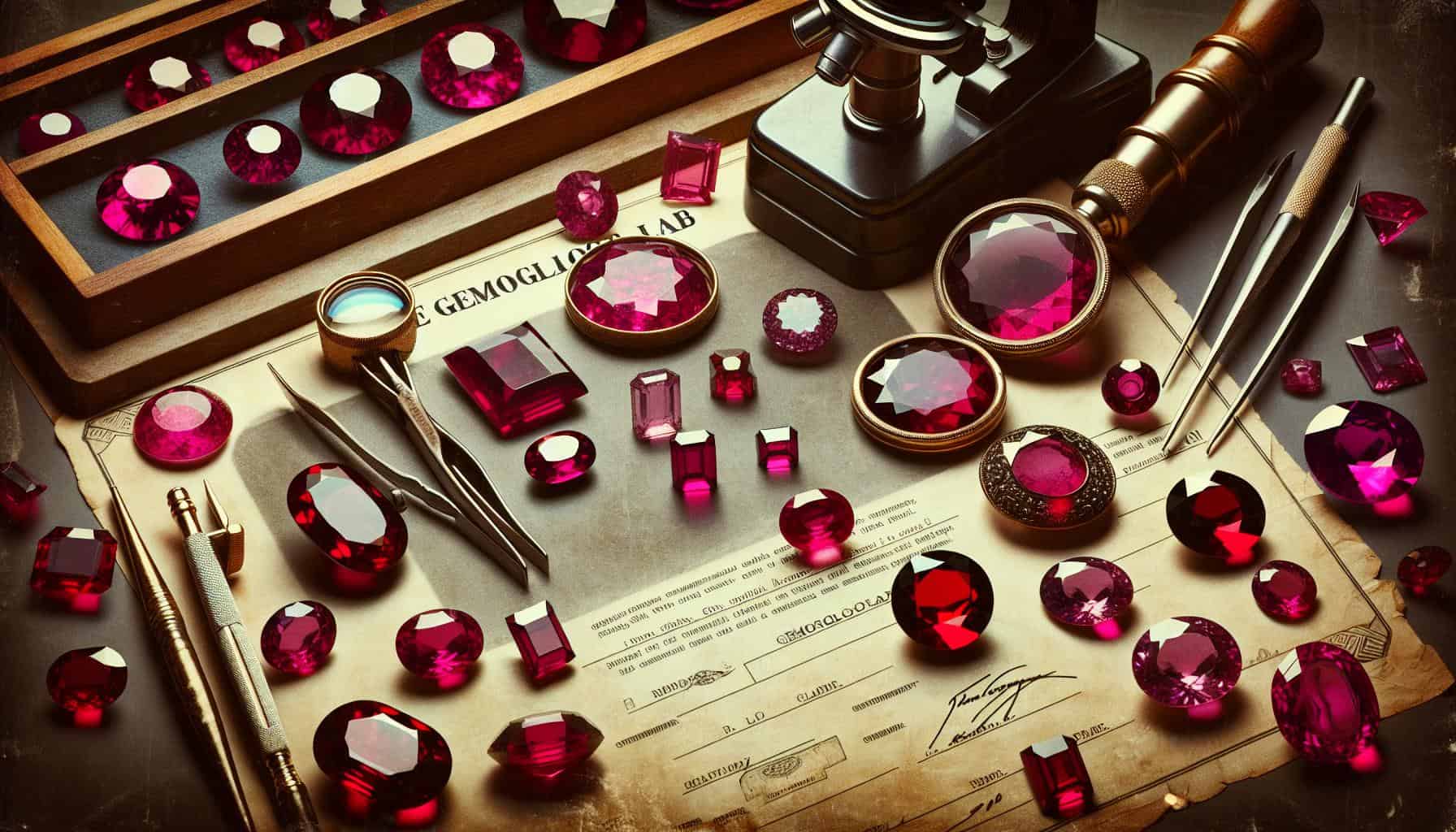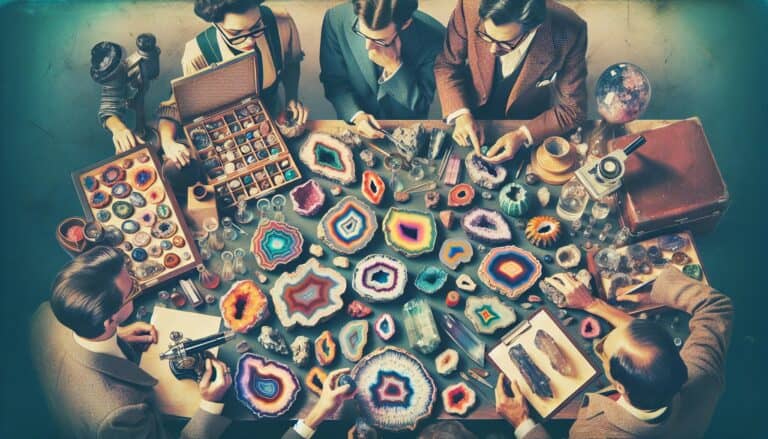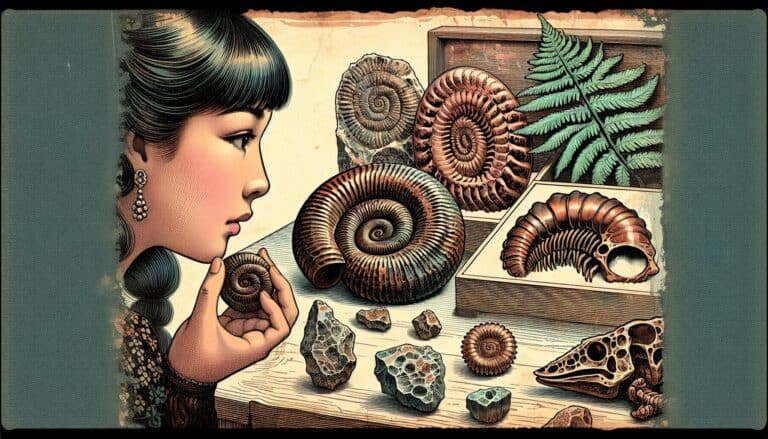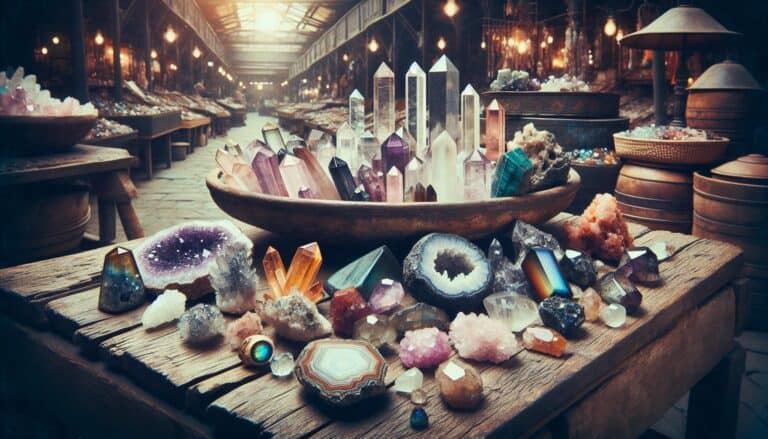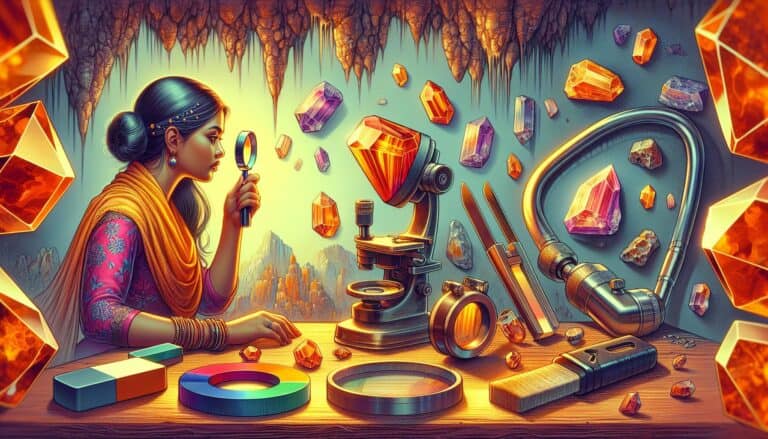Ever wondered what makes rubies so coveted?
These red gems aren’t just stunning—they’re also steeped in value. As you’re eyeing that radiant piece of jewelry, you’re probably asking yourself, “How much is a ruby worth?”
The worth of a ruby is determined by several key factors, including its color, clarity, size, and origin. Each of these elements plays a crucial role in the gemstone’s market value.
Let’s dive into the sparkling world of rubies and uncover what gives them their worth.
Ruby value is influenced by color, clarity, size, and origin. The most valuable rubies have a deep red color, often termed “pigeon’s blood.” Clarity and cut quality also impact value, with clear, well-cut rubies being more desirable. Rarity and origin, especially Burmese rubies, add to their allure and value.
What Is Ruby?
Rubies are one of the most sought-after gemstones in the world, esteemed for their intense red color and exceptional hardness. They fall into the category of corundum, a crystal form of aluminum oxide, which becomes a ruby through the presence of the element chromium. This is what gifts rubies their distinctive hue ranging from pinkish red to a deep, rich red.
Characteristics That Define Rubies
Rubies are more than just their color; they are a symbol of passion and wealth, historically adorned by royalty and sought after by collectors. The key characteristics that make rubies so valuable include:
- The Mohs Scale of Hardness: Ruby scores an impressive 9 out of 10, making it the second hardest natural mineral after diamond. This hardness translates into durability, allowing your ruby jewelry to withstand the rigors of daily wear.
- Luster: When polished, rubies can exhibit a vitreous to silky luster, contributing to their allure and perception of depth.
- Symbolism: Across cultures, rubies represent love, courage, and emotion, enhancing their desirability and sentimentality.
Rubies also possess pleochroism, which means they can show different colors when viewed from different angles, adding to their unique charm.
Ruby Treatments and Enhancements
It’s crucial to acknowledge that rubies often undergo various treatments to enhance their appearance. Common treatments include:
- Heat treatment to intensify color and improve clarity.
- Filling surface fractures with lead glass to minimize visibility.
Be aware that treated rubies, while still valuable, may not fetch as high a price as untreated, natural specimens. When shopping for rubies, knowing whether they have been treated is vital as it impacts their overall value.
Rarity and Origin
The rarity of rubies cannot be overstated. High-quality rubies are harder to find than diamonds, making them an illustrious addition to any jewelry collection. Rubies from Myanmar, historically known as Burmese rubies, are especially prized for their “pigeon’s blood” color—a term used to describe the most saturated and vibrant reds with a very slight blue hue. Other notable sources include Thailand, Madagascar, and Vietnam, with each location producing gems with unique characteristics that influence their worth.
Ruby Prices: Factors That Affect Value

Color, Clarity, and Cut Quality
When you’re trying to determine the value of a ruby, color is king. The most sought-after rubies flaunt a vibrant, deep red called “pigeon’s blood.” These stones command higher prices due to their rarity and demand among collectors and aficionados. However, rubies come in a range of reds, and those with too light or too dark hues fetch lower prices.
Clarity plays a significant role as well. Rubies without visible inclusions, the internal imperfections, are more valuable. Remember though, it’s rare to find a ruby with perfect clarity. Most have some inclusions, and those do not drastically impact their value unless they compromise the stone’s durability or are noticeable at a glance.
The cut quality of a ruby influences two key attributes: the gem’s brilliance and its ability to hide inclusions. A skillfully cut ruby will reflect light beautifully, making the most of its color saturation and minimizing the visibility of inclusions. A well-proportioned cut will maximize the stone’s size and weight, two factors that are vital in valuation.
Market Demand and Availability
Rubies are a hot commodity in the gemstone market, with their prices also driven by demand and availability. High-quality rubies are scarce, and as the desire for these gemstones grows in emerging markets, prices can surge.
To illustrate, take a look at the following table showing how the price rate has changed over recent years:
| Year | Average Price per Carat (USD) |
|---|---|
| 2018 | 1,500 |
| 2019 | 1,800 |
| 2020 | 2,000 |
| 2021 | 2,300 |
| 2022 | 2,500 |
Notice the steady increase? This trend suggests that investing in rubies could be lucrative, especially if market demand continues to rise. Remember, rubies of remarkable quality and size are rarer and highly prized. So, if you stumble upon one, you’re looking at a considerable value.
Moreover, geopolitical factors affect ruby availability. Given that major ruby mines are located in turbulent regions, any instability can result in a decrease of ruby supply to the market, therefore driving prices up. Therefore, when considering the purchase of a ruby, staying informed about the state of global affairs is as important as appreciating the gemstone’s inherent beauty.
Understanding Ruby: A Rare Gem
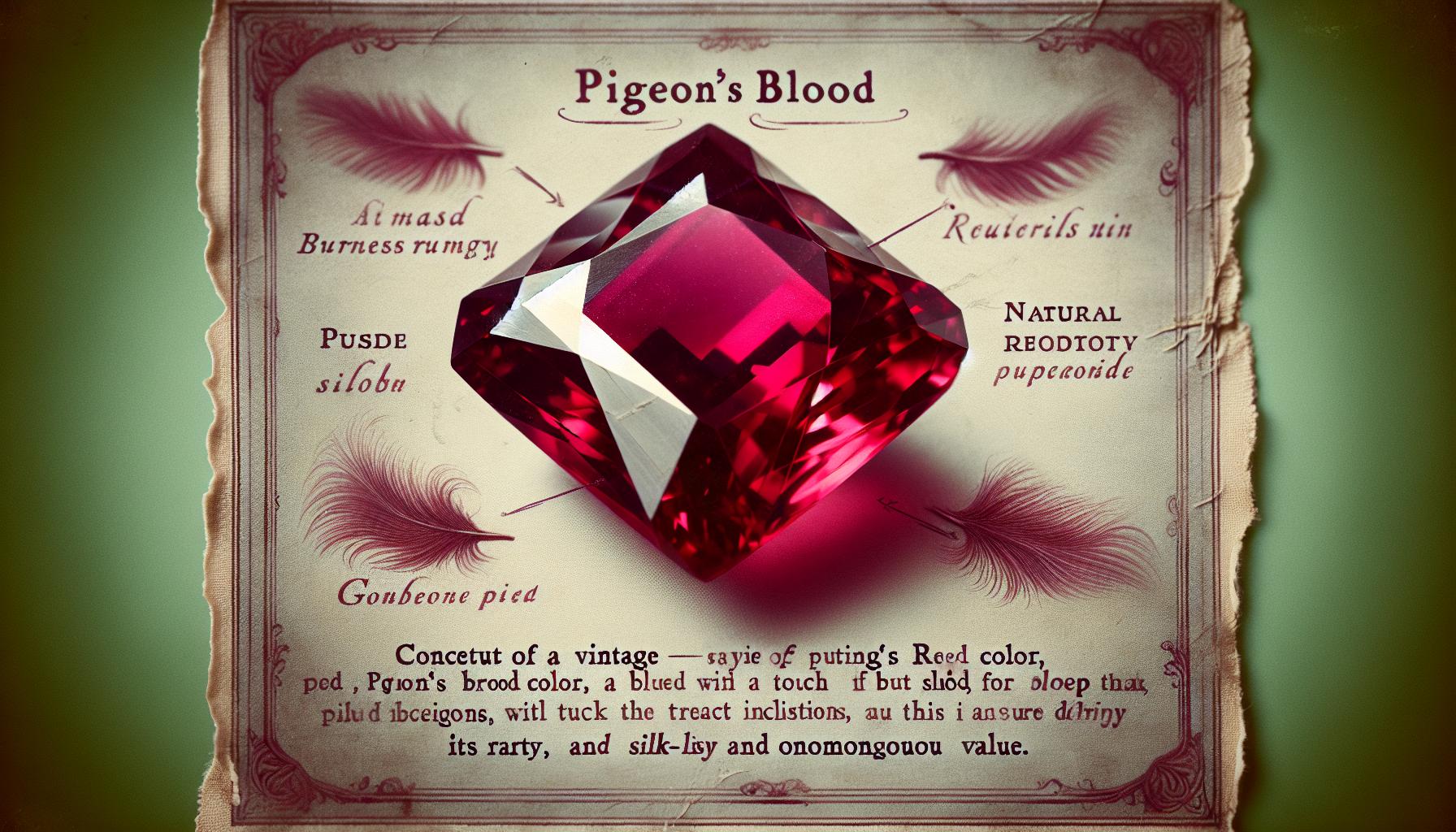
When venturing into the realm of precious stones, you’ll quickly discover the stature and allure that rubies hold. Often positioned proudly alongside diamonds, emeralds, and sapphires, rubies offer a distinct combination of durability and beauty. Their rarity is not just a buzzword—it’s a significant hallmark that dictates their value in the jewelry world.
The Rarity of Ruby
Rubies are among the most coveted gems due to their scarcity. They are a variety of corundum, only second in hardness to diamonds, indicating their durability and suitability for everyday wear. The most exceptional rubies are known for their vivid red color, primarily because of the presence of chromium. Notably, the quantity and location of chromium can vary dramatically, affecting the saturation and consistency of color.
The quantity of high-quality rubies is limited due to their geological scarcity. Extracting these precious stones requires considerable effort, and not every corundum red qualifies as a ruby. Only those with the specific chemical properties and saturation level meet the mark, rendering the majority of corundum finds less valuable.
Origins and Characteristics
Rubies’ worth is closely tied to their origins, with Burmese rubies often fetch the highest prices on the market. However, fine rubies can also emerge from regions like Mozambique, Madagascar, and Sri Lanka, where the geology offers favorable conditions for their formation.
The characteristics of rubies from different localities can vary greatly:
- Burmese Rubies: These are typically prized for their “pigeon’s blood” color—a deep red with a hint of blue.
- Thai Rubies: Usually darker and less vibrant, Thai rubies tend to have a brownish hue.
- African Rubies: These possess a brighter red tone and are becoming prominent in the market due to their relation to their Burmese counterparts.
Each ruby’s unique fingerprint of inclusions, often silk-like threads within the stone, can either enhance its value or detract from its clarity and overall appearance. The interplay of these characteristics profoundly impacts a ruby’s rarity and ultimately its worth on the global stage.
By grasping the rarity of rubies and the nuances of their origins and characteristics, you’re positioned to appreciate why these red gems captivate enthusiasts and investors alike. Understanding the scarcity and unique features of rubies is key to recognizing their value, both aesthetically and monetarily.
Ruby Grading and Valuation
The Grading System for Ruby
When you’re looking to understand a ruby’s value, one of the first things you’ll encounter is its grading system. Rubies are graded on criteria that closely mirror those used for diamonds—color, clarity, cut, and carat weight, known within the industry as the “Four Cs.”
Color is the most critical factor in grading a ruby. The more intense and vivid the red, the higher the gemstone’s value. Clarity refers to the inclusions or internal flaws of the gemstone; fewer inclusions generally mean a higher grade. However, it’s rare to find a ruby without any inclusions. Cut refers not just to the shape but also to the ruby’s proportions and finish, affecting its symmetry and brilliance. Lastly, carat weight has a direct impact on value, with larger, high-quality rubies being exceedingly rare.
- Color
- Hue
- Saturation
- Tone
- Clarity
- Inclusions
- Transparency
- Cut
- Shape
- Proportions
- Symmetry
- Carat
- Weight
- Size
Understandably, two rubies may look similar to the untrained eye but can have vastly different valuations due to these grading differences.
Certification and Appraisal
For peace of mind and assurance of a ruby’s quality and authenticity, certification from a reputable gemological laboratory is critical. These certificates provide a detailed analysis of the gemstone, including the Four Cs mentioned earlier, any treatments the ruby may have undergone, and its origin—which can significantly affect its value.
Top laboratories known for their expertise in gemstone certification include:
- Gemological Institute of America (GIA)
- American Gem Society (AGS)
- International Gemological Institute (IGI)
Appraisal involves an expert examination usually for insurance purposes or resale. An appraiser will take into account the certificate of authenticity, current market trends, and the ruby’s overall appeal, which includes factors like rarity and the quality of the setting if the stone is part of jewelry.
Remember to seek out a certified gemologist or an appraiser with recognized credentials to ensure an accurate and unbiased appraisal of your ruby. Ideally, they should have no interest in the sale or purchase of the piece to maintain objectivity.
Taking these steps not only helps to understand the worth of your ruby but also protects your investment in this precious gemstone. Keep in mind that the gem market is dynamic, and prices can fluctuate based on factors like market demand and rarity of the stones available.
Current Market Trends in Ruby Pricing
When assessing how much a ruby is worth, it’s pivotal to understand the current market trends. The gemstone market is dynamic, with prices that ebb and flow due to various influences. Exploring the recent trends can provide you with a clearer picture of what you might expect to pay or receive for a ruby.
In recent years, there’s been a noticeable increase in demand for natural, untreated rubies. This surge is partly due to their rarity and the market’s inclination toward gems that are free of any enhancements. As a result, prices for these authentic stones have seen a significant upward trajectory. However, treated rubies continue to be available and are an option for those seeking more affordability.
Several factors can affect the ruby pricing trends:
- Global Economic Climate: Like other precious stones, rubies are subject to the whims of the world economy. High-end rubies tend to retain or increase their value during volatile economic periods as investors look for tangible assets to hedge against inflation.
- Fashion Trends: Rubies’ prevalence in high fashion can influence their market value. When a notable designer features rubies prominently, demand can increase, leading to higher prices.
- Geopolitical Factors: The majority of the world’s rubies come from Myanmar, Madagascar, and Mozambique. Changes in political stability or mining regulations in these countries can impact ruby availability and prices.
When looking at the numbers, it’s worth noting that since 2015, the overall market for rubies has grown consistently. For instance, high-quality Burmese rubies have been recorded to sell at auction for as much as $1 million per carat. In contrast, commercial-quality rubies from other sources may be available for several hundred dollars per carat.
As per the latest figures, here’s a rough breakdown of pricing:
| Ruby Quality | Price Range per Carat |
|---|---|
| Commercial-Quality | $100 – $1,000 |
| Fine-Quality | $1,000 – $5,000 |
| Investment-Grade Burmese | Over $1 million |
Remember, while these trends can give you an idea about current pricing, ruby values are subject to change. Keeping abreast of the latest market shifts is critical when considering buying or selling rubies.
The Most Expensive Ruby
Rubies have long been regarded as the king of gems, symbolizing power, passion, and a zest for life. But have you ever pondered which ruby holds the record as the most expensive? The Sunrise Ruby, an exquisite Burmese stone, stands out among its peers. Weighing an impressive 25.59 carats, this pigeon blood-red gem fetched a staggering $30.42 million at a Sotheby’s auction in Geneva in May 2015. That sale shattered all records, making it the priciest ruby ever sold.
The stone’s price can be attributed to its rare combination of features – its color, clarity, cut, and size are virtually unmatched. The Sunrise Ruby, like diamonds, garners its value from a number of critical factors. For instance:
- Color: Its rich, saturated hue is the ideal shade of red for rubies.
- Clarity: The gem possesses an exceptional transparency that is rare in rubies of such size.
- Cut: With a cushion-cut highlighting its symmetry and brilliance, the ruby’s cut presented the stone in the best possible light.
- Origin: Burmese rubies are often considered the benchmark for the finest quality, and the Sunrise Ruby’s origin added to its mystique and worth.
| Feature | Detail |
|---|---|
| Weight | 25.59 Carats |
| Color | Pigeon Blood-Red |
| Clarity | Exceptional Transparency |
| Cut | Cushion-cut |
| Origin | Burma |
| Auction | Sotheby’s, Geneva |
| Sale Date | May 2015 |
| Price | $30.42 Million |
Bagging such a noteworthy price point, the Sunrise Ruby easily eclipses other notable sales, signaling market readiness to invest heavily in top-tier gemstones. Your quest for a ruby should be informed by such exceptional examples, as they set the bar for valuation. Remember, while not all rubies are as remarkable (or as costly) as the Sunrise Ruby, they do exhibit a shared heritage of allure and worth, influenced by their individual characteristics and the market’s desire.
Buying Ruby: Tips and Recommendations
When you’re in the market for a ruby, it’s essential to know where to shop and how to verify the gemstone’s authenticity and value. Finding high-quality rubies can be a complex task, but with the right knowledge, you’ll be able to make a well-informed and valuable purchase.
Where to Purchase High-Quality Ruby
To ensure you’re getting a ruby that’s worth your investment, consider these reputable sources:
- Specialized Gemstone Retailers: Experts in gemstones typically offer a wide selection of quality rubies and provide professional guidance.
- Authorized Jewelers: Established jewelry stores often carry certified rubies and can provide detailed information about each stone’s characteristics.
- Online Gemstone Marketplaces: While convenient, it’s crucial to buy from well-reviewed and trusted online retailers.
Tip: Whenever you shop, ask vendors if their rubies are natural or treated and request a complete history of any enhancements the gemstone may have undergone.
Ensuring Authenticity and Value
To maximize the value of your ruby purchase and ensure its authenticity, adhere to the following guidelines:
- Certification: Always seek a ruby that’s certified by a respected gemological laboratory like the GIA or AGS.
- Inspection: Examine the ruby under different lighting conditions and inquire about any visible inclusions or flaws.
- Documentation: Request detailed documentation that includes the ruby’s origin, treatments, and all factors affecting its value.
Remember that the more you know about the ruby you’re interested in, the better equipped you’ll be to make a decision that you won’t regret. Keep in mind that the rarity and desirability of rubies continue to soar in today’s market, making it even more critical to buy from sources that value transparency and integrity.
Conclusion: Buying & Selling Ruby
Understanding the worth of a ruby is no small feat but you’re now equipped with the knowledge to navigate this vibrant market.
Remember, the true value of a ruby lies in a blend of its color, clarity, cut, and carat weight. Don’t overlook the importance of certification; it’s your assurance of the gemstone’s quality and authenticity. As trends and economic conditions sway the market, natural, untreated rubies remain a sought-after treasure. Armed with these insights and tips for purchasing, you’re ready to invest in a ruby that not only meets your desires but also holds its value for years to come.
Trust in reputable sources and certified gems to make a choice that’s as timeless as the ruby itself.

